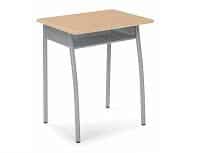Before proceeding to fully enter into the definition of the term desk, it is necessary to know its etymological origin. This leads us to determine that it emanates from the French “pupitre”, which in turn comes from the Latin “pulpitum”, which was a platform or a wooden floor.
The term refers to the table that, in a school, is used by students to write on. For example: “The principal ordered the children to clean their desks,” “Do not eat cookies on the desk,” “Children, remove the notebooks from the desk because today we are going to do an experiment.”
 The design of desks has changed throughout history . They are generally made of wood, although there are also desks with metal components. The oldest desks usually had a lid, a slanted board and a hole for the inkwell.
The design of desks has changed throughout history . They are generally made of wood, although there are also desks with metal components. The oldest desks usually had a lid, a slanted board and a hole for the inkwell.
Nowadays, when the desk does not have a lid, it can have a kind of shelf at the bottom so that students can store books , notebooks, school supplies, etc. The simplest models, however, are limited to having the board on which to write.
Another historical change is that, more than a century ago, desks were group desks. A long bench and a large table made up the desk. In this way, the children lacked freedom of movement. Now, most desks are individual, a feature that contributes to the autonomy of each student and also facilitates their supervision by teachers.
The location of desks in the classroom depends on the available space and the teacher's preferences. Typically, rows are formed with sufficient separation so that you can walk between them.
However, these lines break up on the days when they have to carry out exams. Then it is the teacher who orders his students to separate their desks, to place themselves individually, in order to prevent them from copying or even "snitching" each other's answers.
And all this without forgetting that the existence of what has been called bike desks has recently come to the media. These are unique desks that are equipped with pedals and that are especially designed for hyperactive children, since thanks to them they can release the energy they have pedaling while doing tasks.
In the same way, we cannot ignore that there is an application that goes by the name of Pupitre. We are referring to an app created by the Santillana publishing house, which is aimed at children between 3 and 8 years old and whose objective is to offer them worksheets so that they can improve in the different subjects and in the development of their skills. Specifically, with these proposals they can work from Mathematics to Language, including Social Sciences or even English.
